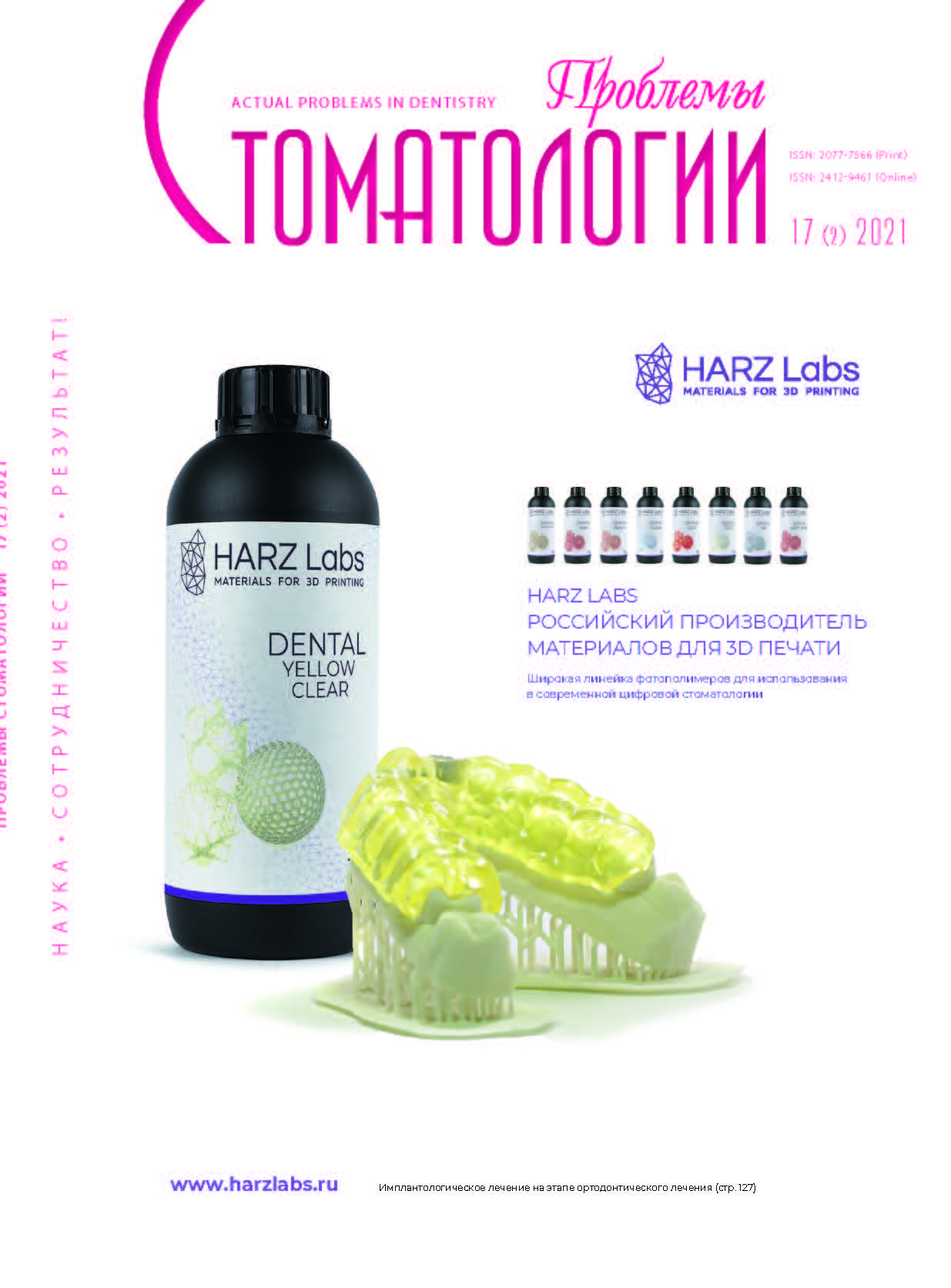Екатеринбург, Свердловская область, Россия
Екатеринбург, Свердловская область, Россия
Екатеринбург, Свердловская область, Россия
Екатеринбург, Свердловская область, Россия
Екатеринбург, Свердловская область, Россия
Екатеринбург, Свердловская область, Россия
Екатеринбург, Свердловская область, Россия
Екатеринбург, Свердловская область, Россия
Екатеринбург, Свердловская область, Россия
На сегодняшний день 16% получаемых травматических повреждений приходятся на область лицевого скелета. Немаловажной является социально-экономическая составляющая данной проблемы, так как в большинстве случаев подобные травмы получают представители трудоспособного населения [4]. Рассматриваемая область требует к себе особого внимания по причине близкого расположения жизненно важных анатомических структур, а также ее эстетической значимости, что во многом определяет уровень социальной реабилитации пациентов с травмами черепно-лицевой локализации, особенно средней зоны лица. Сложность строения структур лицевого скелета, особенности кровоснабжения и иннервации краниофациальной области во многих случаях являются причинами возникновения трудностей в диагностике и лечении пациентов с травмами лица, что в итоге негативно сказывается на качестве оказания им медицинской помощи и дальнейшей реабилитации, социальной адаптации [1-25]. Внедрение цифровых технологий компьютерного моделирования и 3D-принтинга в процессы диагностики и лечения пациентов с переломами костей черепно-лицевой области позволяют минимизировать количество возможных ошибок еще на этапе первичной диагностики, спланировать предстоящее оперативное вмешательство и смоделировать высокоточный индивидуализированный аугмент для замещения костного дефекта [8]. Цифровизация лечебно-диагностических мероприятий позволит вывести на принципиально новый уровень точность проводимой реконструкции, сократить длительность лечения и реабилитации, в том числе социальной [4]. В статье рассмотрены результаты сравнительного анализа традиционного алгоритма диагностики и лечения переломов верхней челюсти в области нижней стенки орбиты с применением стандартной титановой сетки, а также его усовершенствованного варианта, дополненного применением технологий 3D-моделирования и принтинга.
орбита, реконструктивная хирургия, перелом, черепно-челюстно-лицевая хирургия, 3D-технологии, моделирование
1. Абдулкеримов Т.Х., Мандра Ю.В., Абдулкеримов Х.Т., Абдулкеримов З.Х., Мандра Е.В., Болдырев Ю.А., Шимова М.Е., Шнейдер О.Л., Чагай А.А. Современные подходы к диагностике и лечению переломов стенок орбит. Проблемы стоматологии. 2019;15(3):5-11. [T.Kh. Abdulkerimov, Yu.V. Mandra, Kh.T. Abdulkerimov, Z.Kh. Abdulkerimov, E.V. Mandra, Yu.A. Boldyrev, M.E. Shimova, O.L. Shneider, A.A. Chagai. Modern approaches to the diagnosis and treatment of orbital wall fractures. Actual problems in dentistry. 2019;15(3):5-11. (In Russ.)]. https://www.elibrary.ru/item.asp?id=41212337
2. Brennan P., Schliephake H., Ghali G.E., Cascarini L. Maxillofacial surgery. 3-rd ed. St. Louis : Elsevier. 2017:1562.
3. Ehrenfeld M., Manson P., Prein J. Principles of internal fixation of the Craniomaxillofacial skeleton. Trauma and orthognathic surgery. Zurich : Thieme. 2012:395.
4. Abdulkerimov T., Mandra Y., Gerasimenko V., Tsekh D., Samatov N., Mandra E., Gegalina N., Yepishova A. Frequency of the orbital walls fractures. A retrospective study // Actual problems in dentistry. - 2019;2.
5. Al-Moraissi E. et al. What surgical approach has the lowest risk of the lower lid complications in the treatment of orbital floor and periorbital fractures? A frequentist network meta-analysis // Journal of Cranio-Maxillofacial Surgery. - 2018;46:2164-2175.
6. Barcic S. et al. Comparison of preseptal and retroseptal transconjunctival approaches in patients with isolated fractures of the orbital floor // Journal of Cranio-Maxillofacial Surgery. - 2018;46;3:388-390.
7. Cohn J.E., Smith K.C., Licata J.J., Michael A., Zwillenberg S., Burroughs T., Arosarena O.A. Comparing Urban Maxillofacial Trauma Patterns to the National Trauma Data Bank©. // Ann Otol Rhinol Laryngol. - 2019.
8. Costan V.V. et al. The Impact of 3D Technology in Optimizing Midface Fracture Treatment - Focus on the Zygomatic Bone // J Oral and Maxillofac Surg. - 2012;79(4):880-891.
9. Darwich A. et al. Biomechanical assessment of orbital fractures using patient-specificmodels and clinical matching // J Stomatol Oral Maxillofac Surg. https://doi.org/10.1016/j.jormas.2020.12.008
10. Donohoe E. et al. A review of post-operative imaging of zygomaticomaxillary complex fractures without orbital floor reconstruction in University Hospital Galway // Advances in Oral and Maxillofacial Surgery. - 2021;3. https://doi.org/10.1016/j.adoms.2021.100092
11. Farber S.J. et al. Current management of zygomaticomaxillary complex fractures: a multidisciplinary survey and literature review // Craniomaxillofacial Trauma Reconstr. - 2016;9(4):313-322.
12. Halsey J.N., Hoppe I.C., Granick M.S., Lee E.S. A Single-Center Review of Radiologically Diagnosed Maxillofacial Fractures: Etiology and Distribution // Craniomaxillofac Trauma Reconstr. - 2017;10(1):44-47.
13. Harrington A.W. et al. External Validation of University of Wisconsin's Clinical Criteria for Obtaining Maxillofacial Computed Tomography in Trauma // J Craniofac Surg. - 2018;29:e167-e170.
14. Haworth S. et al. A clinical decision rule to predict zygomatico-maxillary fractures // J Cranio-Maxillofacial Surg. - 2017;45:1333-1337.
15. Latif K. et al. Post operative outcomes in open reduction and internal fixation of zygoma bone fractures: two point versus three point fixation // Pakistan oral Dent J. - 2017;37(4):523-530.
16. Willemink M.J., Noël P.B. The evolution of image reconstruction for CT-from filtered back projection to artificial intelligence // Eur Radiol. - 2019;29:2185-2195.
17. McCormick R.S., Putham G. The management of facial trauma // Head and neck surgery. - 2018;36;10:587-594.
18. Metzger M.C., Schцn R., Tetzlaf R. et al. Topographical CT-data analysis of the human orbital floor // Int J Oral Maxillofac Surg. - 2007;36(1):45-53.
19. Nikunen M. et al. Implant malposition and revision surgery in primary orbital fracture reconstructions // J Cranio-Maxillofacial Surg. - 2021:1-8.
20. Ord R.A., El-Attar A. Acute retrobulbar hemorrhage complicating a malar fracture // J Oral Maxillofac Surg. - 1982;40(4):234-236.
21. Pyötsiä K., Lehtinen V., Toivari M., Puolakkainen T., Wilson M.L., Snäll J. Three-dimensional computer-aided analysis of 293 isolated blowout fractures - which radiological findings guide treatment decision? // Journal of Oral and Maxillofacial Surgery. - 2021. https://doi.org/10.1016/j.joms.2021.06.026
22. Sanjuan-Sanjuan A., Heredero-Jung S., Ogledzki M., Arévalo-Arévalo R., Dean-Ferrer A. Flattening of the orbital lower eyelid fat as a long-term outcome after surgical treatment of orbital floor fractures // J Oral Maxillofac Surg. - 2019.
23. Scolozzi P. et al. Are Inferior Rectus Muscle Displacement and the Fracture's Size Associated With Surgical Repair Decisions and Clinical Outcomes in Patients With Pure Blowout Orbital Fracture? // J Oral Maxillofac Surg. - 2020;78:2280.e1-2280.e10.
24. Timashpolsky A. et al. A prospective analysis of physical examination findings in the diagnosis of facial fractures: determining predictive value // Plast Surg (Oakville, Ont). - 2016;24:73-79.
25. Varjonen E.A. et al. Remember the vessels! Craniofacial fracture predicts risk for blunt cerebrovascular injury // J Oral Maxillofac Surg. - 2018;76:1509.e1-1509.e9.




















